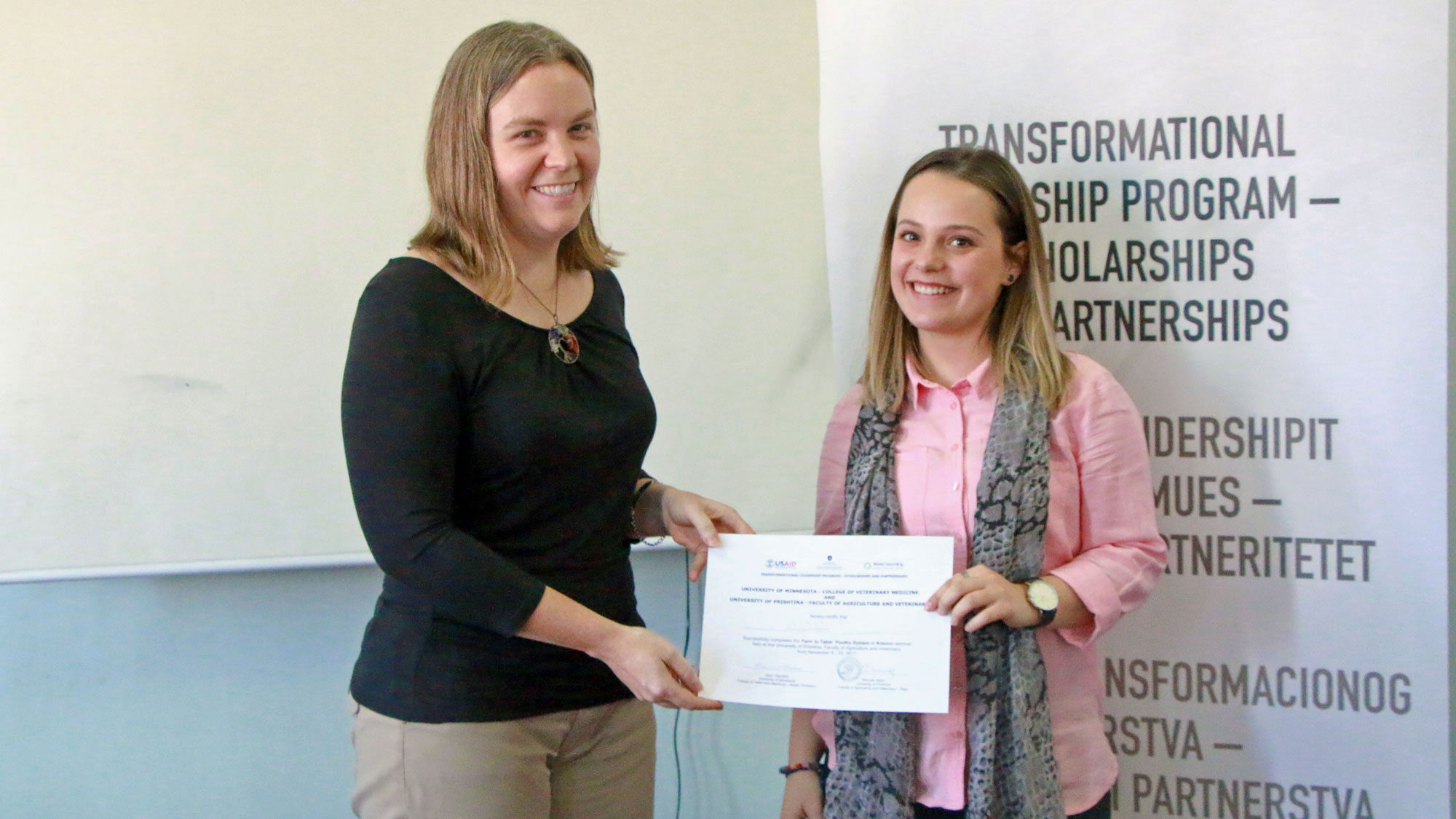
Hamilton, left, with a University of Prishtina, Kosovo veterinary student during an in-country training
CAHFS’ Veterinary Public Health and Preventive Medicine Residency trains veterinary professionals around the globe
Karin Hamilton, DVM, MPH, DACVPM, directs the University of Minnesota’s Veterinary Public Health and Preventive Medicine Residency (VPHPM), a two-year residency program through the Center for Animal Health and Food Safety (CAHFS). The program is designed as an immersive hands-on training that gives early- to mid-career veterinarians specialized training in veterinary public health.
“The VPHPM residency is the only one of its nature in the world to my knowledge,” says Hamilton, a graduate of the program. “It’s different than a PhD because the purpose of the residency is to give participants a breadth of practical experience across the veterinary public health fields.”
The program, which was founded in 2002, was the first in the United States to receive recognition from the American College of Veterinary Preventive Medicine. It is now one of just two in the U.S. that are accredited by the specialty board—the other being a masters program at the Ohio State University. The U of M VPHPM residency draws applicants from across the globe, with an average of six enrolled in the program at any one time. The program's structure emphasizes hands-on experience working with a variety of stakeholders, while maintaining the highest quality of instruction and mentoring.
During a 2015 avian influenza outbreak, VPHPM veterinarians carried out an epidemiological study examining how the disease spread. Residency work is done in partnership with multiple non-clinical sectors, including different departments at the U of M, government agencies, non-profit organizations, and private companies. It also provides a unique opportunity to develop skills not only in food safety, zoonotic diseases, and economically influential animal diseases (such as African swine fever), but also an understanding of how these stakeholders function together in practice.
Jeein Chung, DVM, MPH, DACVPM, says he worked on more than 12 different projects throughout the residency. “That range of projects and tasks helped me learn how to juggle different stakeholders and prepared me to deal with a lot of different people,” says Chung.
Chung first worked in Southeast Asia as a liaison between universities in Thailand, Vietnam, Malaysia, and Indonesia. He built educational and training workshops related to the Southeast Asia One Health University Network working with veterinary medicine, public health, and medical schools, as well as governments. After that, Chung moved to Uzbekistan, where he built training programs for an epidemiology and laboratory diagnostics fellowship that brought Uzbek veterinarians and medical laboratory staff to the United States. He also conducted in-country assessments related to infectious diseases before returning to the United States himself to work across multiple sectors, including another consulting contract with the Department of Defense.
A number of program alumni work in state or federal government jobs—as state public health veterinarians, emergency management with the United States Department of Agriculture, or epidemic intelligence services with the Centers for Disease Control and Prevention, for example—while others conduct research at universities or work as consultants in the private sector.
Another residency alumna, Susan Gale, DVM, MPH, worked for 20 years as a small animal veterinarian before seeking out the residency, looking for a career change. “I was always interested in epidemiology and public health and realized I couldn’t afford to get a master’s degree on my own,” says Gale. “The residency provided me that opportunity along with a variety of experiences.” Hamilton says most residents pursue a master’s degree in tandem with the program, taking advantage of the full tuition benefit that the University offers to residents.
After completing the residency, Gale worked with the Arizona Department of Agriculture where she focused on emergency preparedness for livestock facilities near one of the largest nuclear power plants in the country. “Preparing for a nuclear accident is very similar to preparing for disease outbreak,” says Gale. “You need to control the movement of exposed animals to ensure a safe food supply.”
Gale now works for the Arizona Department of Gaming Division of Racing where she’s the state’s chief regulatory veterinarian for horse racing. In this role, she monitors disease, injury, and improper drug use. “Being able to compile and communicate information for a variety of audiences is key to my job,” says Gale. “The residency provided me with the necessary skills for this stage in my career.”
Hamilton takes pride in the program’s alumni. “That’s one of the cool things about this residency, it prepares residents for such a variety of careers.”
Learn more about our VPHPM residency at cahfs.umn.edu/residency
